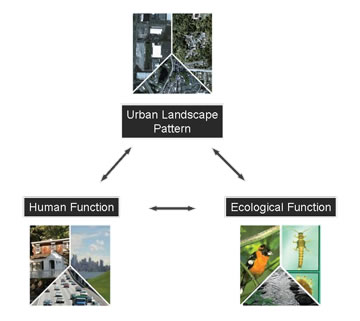 In the UERL, we have done extensive work to characterize a variety of landscape patterns for the Puget Sound region.
In the UERL, we have done extensive work to characterize a variety of landscape patterns for the Puget Sound region.
Urban landscape patterns are emergent, coupled human-natural phenomena that epitomize the complexity of interactions and feedback mechanisms between human decisions and ecological processes.
The process of urbanization results in a complex pattern of intermixed high- and low-density built-up areas and fragmented natural patches.
Alternative urban development patterns affect ecological processes both directly—by replacing native habitat with simplified, human-dominated systems—and indirectly—by rearranging the biophysical attributes that cause a variety of interrelated local and global effects.
Read more:
Projects:
Linking urbanization and vegetation carbon patterns
RGI2: Landscape Composition and Configuration at the Basin and Sub-Basin Level in Western Washington
CTED Landscape Benchmarks Project
Detecting Ecological Signatures of Development Patterns
The Impact of Urban Patterns on Aquatic Ecosystems: An Empirical Analysis in Puget Lowland Sub-Basins
Publications:
Michalak, J. 2011. Effects of Habitat and Landscape Structure on Oregon White Oak (Quercus garryana) Regeneration Across an Urban Gradient. Northwest Science 85:182-193.
Alberti, M., Booth, D., Hill, K., Avolio, C., Coburn, B., Coe, S., and D. Spirandelli 2007. The impact of urban patterns on aquatic ecosystems: An empirical analysis in Puget lowland subbasins. Landscape and Urban Planning, 80: 345–361.
Alberti, M. 2007. Ecological signatures: The science of sustainable urban forms. Places. 19(3): 56-60.
Alberti, M. 2005. The effects of urban patterns on ecosystem function. International Regional Science Review. 28(2):169-192.